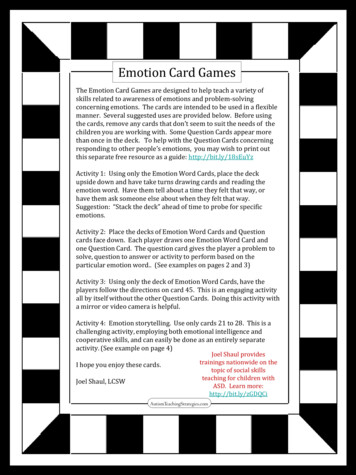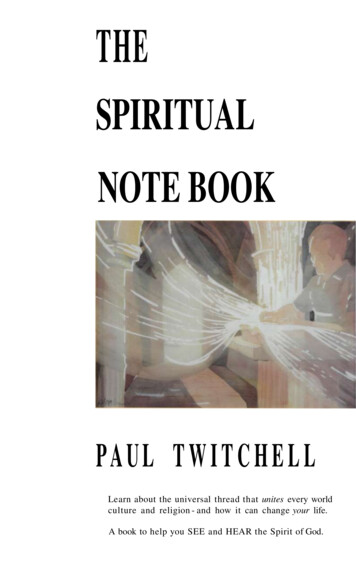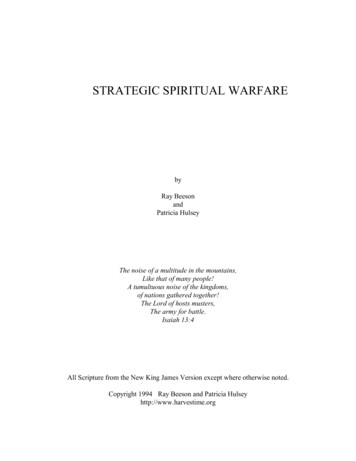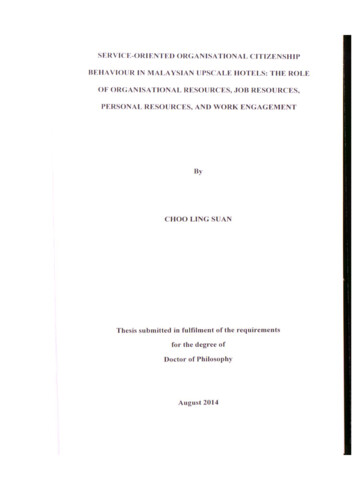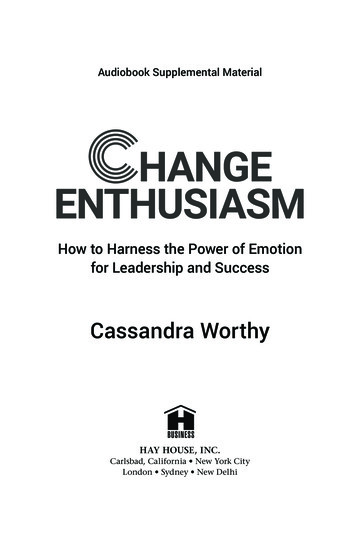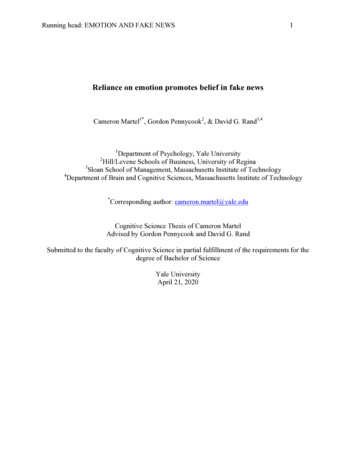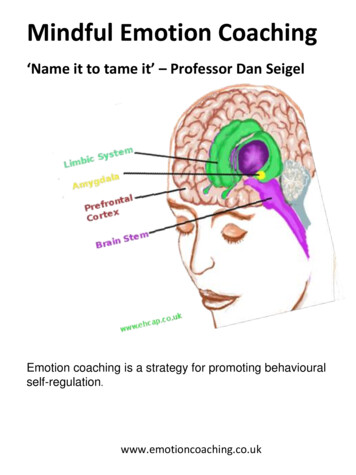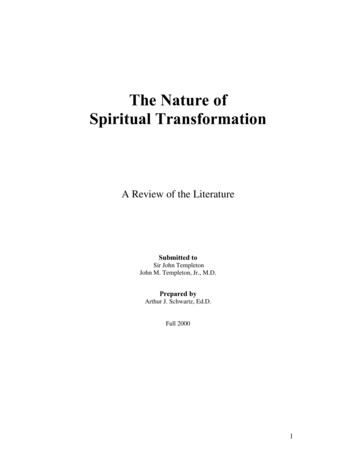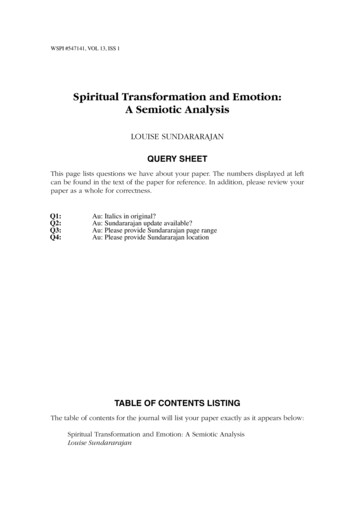
Transcription
WSPI #547141, VOL 13, ISS 1Spiritual Transformation and Emotion:A Semiotic AnalysisLOUISE SUNDARARAJANQUERY SHEETThis page lists questions we have about your paper. The numbers displayed at leftcan be found in the text of the paper for reference. In addition, please review yourpaper as a whole for correctness.Q1:Q2:Q3:Q4:Au: Italics in original?Au: Sundararajan update available?Au: Please provide Sundararajan page rangeAu: Please provide Sundararajan locationTABLE OF CONTENTS LISTINGThe table of contents for the journal will list your paper exactly as it appears below:Spiritual Transformation and Emotion: A Semiotic AnalysisLouise Sundararajan
Journal of Spirituality in Mental Health, 13:1–13, 2011Copyright Taylor & Francis Group, LLCISSN: 1934-9637 print/1934-9645 onlineDOI: 10.1080/19349637.2011.547141Spiritual Transformation and Emotion:A Semiotic AnalysisLOUISE SUNDARARAJANRegional Forensic Unit, Rochester, New YorkThe semiotics of Charles Sanders Peirce is proposed as a theoretical framework that can model more adequately than conventionaltheories in psychology the emotional transformations in culturalpractices that rest squarely upon self-transcendence as the basis forhealing. For illustration, the Peircean notion of the sign is appliedto an analysis of spirit healing in Puerto Rico. Clinical implications for psychotherapy in general, and treatment for alexithymiain particular, will be explored.510KEYWORDS semiotics, Charles Sanders Peirce, spirit healing,alexithymia, dialogical selfCentral to the phenomena of spiritual transformation is self-transcendence,referred to by Deikman as “the loss of self” (1966), by Ricoeur (1974) as “displacement of the center” (p. 462), and by Mahoney and Pargament (2004) asa “fundamental shift in one’s relationship to the sacred, such that the sacredbecomes the center” (p. 490). This calls into question the conventional wisdom in psychology that centers on the atomic self as the foundation for allthings psychological. This article demonstrates how the semiotics of CharlesSanders Peirce, a contemporary of William James and father of the Americanpragmatism, offers a more suitable framework for the phenomena of spiritualtransformation. For illustration, a semiotic analysis will be applied to practices of spirit healing in Puerto Rico as documented by the anthropologistKoss-Chioino (1996, 2006).Exposition on the Peircean semiotics consists of three parts: First, Iintroduce, as alternative to the atomic self, a semiotic self (Wiley, 1994)A draft of this article was presented in August 2007 at the American PsychologicalAssociation Annual Convention in San Francisco.Address correspondence to Louise Sundararajan, Ph.D., 691 French Rd., Rochester, NY,14618. E-mail: louiselu@frontiernet.net1152025
2L. Sundararajanwhich is a formulation of the self in terms of the structure and functionof the sign. Next, I underscore the connection between sign and mind byapplying the notion of mental spaces (Fauconnier & Turner, 2002) to mapout the triadic structure of the sign. Third, I explain the Peircean notion ofsign function, with special focus on the implication that an efficient sign useris one who participates in efficient sign functioning. Various permutationsof this theme are used to explain spirit healing. Clinical implications forpsychotherapy in general and treatment for alexithymia in particular will beexplored.3035FROM ATOMIC TO SEMIOTIC SELFThe atomic self is part and parcel of the foundationalism prevalent inpsychology. The need for a foundation to ground our experiences is manifest not only in the atomic self but also in the quest for basic emotions(Sundararajan, 2008). An antidote for this foundationalism is the Peirceansemiotics that claims that representations, whether of self or emotion, arede-centered processes. The basic premise of the Peircean semiotics is thatthe relationship between any two terms is always mediated by a third term.The most radical expression of this claim is his notion of self-reflexivity thatpostulates the self to self-transaction—such as thought talking to itself—as a relationship mediated by a third term. This position has been takenby other thinkers as well, for instance Hegel: “For Hegel, reflexivity isnot directly self-to-self, but indirect, via the other” (Wiley, 1994, p. 78).Herbert Mead referred to this self-reflexive loop as “triadic,” for “it alwayshas a three-point, self-other-self . . . recursivity” (Wiley, 1994, p. 122). The“self-other-self” recursive loop translates readily into Bogdan’s (2000) “mindworld-mind” formulation, which renders more explicit the triadic structureinherent in the intermental (mind to mind) transactions. Permutations of thetriadic intermental transactions are presented in Figure 1.As Figure 1 shows, the intermental (mind to mind) transactions consist of three terms: Mind 1, Mind 2, and a third term. For instance, in thecaretaker and infant transaction, this entails two minds—the child’s and thecaretaker’s—sharing a third thing, the world (Figure 1, B). A cognate insightmay be drawn from child development. Dyadic relationship between theinfant and the care taker is referred to as “primary intersubjectivity” in whichsocial signals are not directed toward a third term but rather toward theinfant personally (Trevarthen, 1998). A more mature type of transaction istriadic intersubjectivity, characteristic of social referencing, which childrenfrom 8 or 9 months of age are capable of—when faced with ambiguoussituations, young children look to adults’ facial expressions for guidancein interpreting the world as safe or dangerous, for instance. As Bogdan(2000) points out, social referencing is “triangular” in that it consists of “themind-world-mind triangle” (p. 120).40455055606570
Spiritual Transformation and Emotion3FIGURE 1 The Triadic Structure of Intermental TransactionsIn the framework of mind-mind-world, the third term signifies not anumerical so much as an ontological difference—it is an other to the rest ofthe set. For instance “the world” is other, in terms of ontological status, tothe two parties of a conversation. Presence or absence of an other—knownas alterity or Other in the dialogical self-literature (Salgado & Gonçalves,2007)—may be a differentiating factor between closed and open dialogues.In closed dialogues, such as ruminative self-talk (Nolen-Hoeksema, Wisco,& Lyubomirsky, 2008), the two parties of a conversation are tightly coupled to form one fixed mode of processing that recycles ad nauseum as ifone were breathing in and out of a brown bag. In the context of neuroscience, the dyadic interaction between two systems is rightly referred to byLewis (2002) as “internal monologue” (p. 182). Lewis (2002) interprets thepersonal positioning of the dialogical self (Hermans, 2001) as shifting monologues between two competing attention systems of the brain. But dyadictransactions—be it self-talking to an anticipated other or thought talking toitself—cannot be the basis for an open dialogue. What keeps the dialogueopen is the insertion of the third term—an Other, in the sense of a newelement outside the system, from another brain or from the world outsidebrains, for instance—into the flux of a conversation.The triadic structure of mind-to-mind transactions is evident in any standard therapeutic relationship, in which the therapist or the healer is thirdparty to the client’s self-to-self intrapersonal dialogue (Figure 1, A). Butspirit healing goes one step further—it articulates another level of mediated relationship, in which an encounter between the healer and the clientis mediated by the spirit as the third party (Figure 1, C). As Koss-Chioino(1996) points out: “The healer-client encounter is almost always a triadic(or even larger) relationship in ritual healing—between healer (or healers),client and spirit or spirits (or gods)” (p. 263). In the theoretical framework of7580859095
4L. SundararajanCharles Peirce, the mediated relationship of dialogues, intrapersonal as wellas interpersonal, is a direct consequence of the triadic structure of the sign, 100to which we now turn.TRIADIC STRUCTURE OF THE SIGNAccording to Charles Peirce (Parmentier, 1994; Colapietro, 1989), the conventional dyadic relationship between signifier and signified is mediated bya third element—the “interpretant” which refers to the mental operations thatmake interpretations possible. Thus the sign consists of three terms insteadof two: representamen (the signifying sign), object (the object of signification), and interpretant (interpretation). To reiterate the fact that the Peirceansemiotics concerns primarily mental operations (Deacon, 1997), I use thenotion of mental spaces (Fauconnier & Turner, 2002) to map out the triadicstructure of the sign. Mental spaces are temporary and dynamic conceptualframeworks that function as affordances for specific mental operations. Inthe words of Fauconnier and Turner (2002): “Mental spaces are small conceptual packets constructed as we think and talk, for the purposes of localunderstanding and action . . . . Mental spaces can be used generally to modeldynamic mappings in thought and language” (p. 40). According to Brandtand Brandt (2005), multiple mental spaces are needed to introduce the threeterms of a semiotic sign in the Peircean framework (see Figure 2).As illustrated by Figure 2, presentation space supports the task of representation or expression by means of the signifying sign, reference spacevalidation of the subjective experience, and virtual space the function ofinterpretation. According to Brandt and Brandt (2005), the virtual space ison a different plane of being—it is not situated in reality space, in whichpresentation space and reference space reside.The importance of the virtual space is brought home by the followingsong that typically begins a ritual healing ceremony of Haiti:105110115120125When the laplas (ritual assistant) arrivesTo unfurl my flagI am going to see where my oungan [priest] is. (Wexler, 1997, p. 59)According to Wexler (1997), the song marks the moment for the ritual 130entry of the Vodou flags into the temple: “Haitian Vodou flags, often richlyornamented with sequins and beads, are unfurled and danced about duringceremonies to signal the spirits” (p. 59). But this is not a simple 1-to-1 correspondence of flag spirits. The framework of mental spaces (Fauconnier& Turner, 2002) makes this clear: The flag first of all introduces the virtual 135
Spiritual Transformation and Emotion5FIGURE 2 The Triadic Structure of a Sign Mapped Out in Mental Spacesspace, which supports the symbolic mindset. With the introduction of thevirtual space, one is no longer mired in the mental space of everyday reality.Virtual space in turn determines the appearance of the priest in the presentation space—as indicated by the song, the priest will be “seen” only whenthe flag unfurls. In other words, it is only when one is thinking symboli- 140cally thanks to the instantiation of the virtual space that one is able to seeJoe Schmo as “my priest.” With both the presentation space and the virtualspace properly set up or activated, we can then expect to see “the oungan(priest) and the flag double as points of entry for the lwa (spirits), directing their energies into the ceremony” (Wexler, 1997, p. 59). The fact that 145“seeing the flag and seeing the oungan were intertwined events” (Wexler,1997, p. 59) attests to the unique temporal framework of the semiotic sign.As Parmentier (1994) points out, “The sign relation . . . necessarily involvesthree elements bound together in a semiotic moment” (p. 25). But where isthe third element of this semiotic moment, in addition to the spirit and the 150priest? It is the client, whose experiences—as indicated by the “I” and “my”Q1
6L. Sundararajanin the song (“I am going to see where my oungan is”)—constitute the pointof reference for it all. Another way of putting it is that the client resides inthe reference space.This complex web of relations among the mental spaces of a semiotic moment will be elaborated later. Suffice it to note at this point thatit is the introduction of the virtual space that sets in motion the chain ofevents. This observation is consistent with spirit healing in Puerto Rico,where the beginning and end of the ritual healing are coterminous withthe opening and closing of the virtual space, respectively. As Koss-Chioino(1996) points out, the beginning of a healing session is devoted to theopening and preparing to receive spirit influences, whereas at the end,spirit influences are sealed off from the mundane world, and life foldsback again into the plane of a lower dimensionality—the reality space. Itis in spirit healing that the incommensurability, the otherness, of the virtual space as a third term in the semiotic web of relations is most clearlymarked.With the three mental spaces—virtual, presentation, and reference—simultaneously instantiated, adequate representation of experience isthereby made possible. But why representation of experience in the firstplace? Representations render visible or reportable what is otherwise cognitively unavailable. The importance of representation is best summed up byCharland’s (1995) dictums of “feeling is representing”; and “no representation, no experience” (p. 73). Adequate representation of experience is partand parcel of efficient sign functioning, to which we now turn.155160165170175HEALING AS PARTICIPATION IN EFFICIENT SIGN FUNCTIONINGTo recapitulate, the self is a de-centered process that is structured like asign. One implication of this equation of the sign user and the sign is thathealing may be understood in terms of facilitating the client’s participationin efficient sign functioning. An analysis of spirit healing in terms of efficient 180sign functioning may begin with the following vignette from Puerto Rico asa paradigmatic case.At one spirit healing session two healer-mediums worked on Jose, 35year-old man. The spirits molesting Jose were either “seen” and reportedby the medium or possessed and spoke through the medium. The first 185spirit talked about extreme agitation and loss of control over behavior,accompanied by inability to think. The second spirit was severely hurt(“bloody,” self-destructive, the “darkness” in this man) by a work accidentsomehow associated with the client’s agitated “craziness” and lack of conformity. A third spirit, seen by the medium, exposed the client’s wounding 190anger and frustration in relationship to his wife. Finally, a fourth spirit from
Spiritual Transformation and Emotion7within the possessed medium addressed the client’s underlying, possiblysuppressed feelings, which were withdrawal, alienation, hopelessness andabandonment. Here is the transcript:A spirit arrives here named Pedro Cruz who wants to put you in a stateof agitated desperation. He takes your mind away. Sometimes you leaveyour house and arrive at another place. You have to control yourself inorder not to run around or cry . . . . You are like a crazy person; you don’thave a mind nor can react. [And then another spirit is seen who is] bathedin blood; he is a “spirit of color” [a reference to being dark-skinned], hecomes to a machine and puts his hand on the tire. It could be someaccident that you have had. [When the client says he no longer worksat that job the medium “captures” that he left the work for a reason.She adds that he never conforms and although he tries to free himselfthe spirit says he is “caught.”] He [the spirit] has you enclosed with yourhands tied. [One of the mediums then asks if the client is jealous.] Is ityou or your companion? These are diabolical, destructive jealousies. Let’ssee what it has to do with this spirit. [She then is possessed. The spirit,speaking through her, says] I will not greet you. Nobody looks at me.And that is how he is. No one helps him . . . . I come with strength. Whatare you going to do with me? Me, who was so hidden. (Koss-Chioino,1996, p. 258)195200205210The stage is now set for an analysis of spirit healing within theframework of efficient sign functioning.Efficient Sign Functioning215According to Charles Peirce (Rosa, 2007; Lee, 1997), a fully developed signhas three modes of representation—icon, symbol, and index—each contributing uniquely to the overall efficiency of the sign. The icon embodiesa relationship of contiguity between the representation and its object toensure fidelity in representation; the symbol is one step removed from the 220object of representation to facilitate further elaboration through interpretations; and the index is a reference loop that counterbalances the abstracttendency of the symbol by calling attention to the object of representation.Equipped with these three modes of representation, a fully developed sign istherefore capable of integrating its multiple functions—the concrete expres- 225sion of suffering (a function of the icon), understanding through elaborationand interpretation (a function of the symbol), and validation of subjective experience (the indexical function that calls attention to the object ofrepresentation).All these modes of representation seem to be operative in the spirit 230healing.
8L. SundararajanHealer’s Body as Iconic RepresentationIcon describes a sign relation in which the signifying sign (representamen) isin a relation of spatiotemporal contiguity with the object of its representation(object), such that the former has to be actually modified by the latter (Lee,1997). This requirement is met by the healer’s body, which functions asa sign in the Representation space. According to Koss-Chioino (2006), inorder to represent or “makes visible what has only been sensed or felt”(p. 28), the healer/medium has to physically experience the afflictions theclient is suffering from: “The medium experiences the feelings as felt bythe sufferer (plasmaciones), communicated through spirit visions (videncias)and/or possession by a spirit” (p. 885). Note that the spatial-temporal cooccurrence of affliction between the healer and the client is made possibleby the intersubjective space, as Koss-Chioino (2006) points out: “Spirit workis based on the emergence of an intersubjective space where individualdifferences are melded into one field of feeling and experience shared byhealer and sufferer” (p. 882). This interchange of affect consists of a mutualtuning-in and sensitization to feelings and emotions that flow between healerand client, resulting in a parallelism of inner states between the two parties.The iconic representation can best be illustrated by the practice of molding or plasmar (i.e., mold, form in one’s own bodies), in which the spiritcausing distress in the client would affect healer’s body the same way (KossChioino, 1996). The function of the healer’s “mirroring” the affliction of theclient is to make a “diagnosis (that is, getting evidence) that describes thespirits and their reasons for causing distress to the sufferer” (Koss-Chioino,2006, p. 882). But molding has another function besides providing diagnostic information, namely, it serves as an index. The difference between iconand index is summed up by Parmentier (1994) as follows: Whereas an iconprovides some information about reality, such as the client’s suffering anddistress, an index “directs the mind to some aspect of [that] reality” (p. 7).The function of the indexical sign relation resides in the reference space.235240245250255260Client as Reference SpaceIn addition to providing diagnostic information, “molding” also draws attention to the client’s experience as point of reference for all interpretations.This is the function of the index, which, like the finger that points at 265the moon, is a sign that “has the effect of drawing the attention ofthe interpreter to its object” (Lee, 1997, p. 120). As Koss-Chioino (1996)points out, clients in the spirit healing do not usually verbally expresstheir own feelings beyond confirming or denying the healer’s descriptionand interpretation of their experiences. Having confirmation and avowal 270of experience as his or her sole responsibility, the client embodies theReference Space, which makes possible a reference loop from interpretationback to experience. This indexical reference loop that matches the healer’s
Spiritual Transformation and Emotion9“mirroring” with the client’s stress is essential for the “uniting of feeling andimage” (Koss-Chioino, 1996) in spirit healing. An analogous mechanism is 275“social biofeedback” (Gergely & Watson, 1996), which makes it possiblefor the infant to construct emotional states, in particular, discrete feelings.Campos, Frankel, and Camras (2004) explain:Social biofeedback refers to the process wherein the parent, by selectively exaggerating and mirroring the infant’s expressions, helps shapethe expressions into more regular patterns and enables the child to matchthe feedback from his or her emotional expressions to his or her feelingstates. (p. 387)280In addition to the backward movement of the indexical reference loop,a sign is capable of a forward movement toward further articulation or inter- 285pretation. This forward movement pertains to the sign relation as symbol, afunction performed by the spirit as interpretant.Spirit as InterpretantThe function of the sign as symbol is what is meant by Peirce as the interpretant. The mental space that makes it possible for the interpretant tofunction properly is the virtual space. The interpretant par excellence isthe sign referred to as spirit in ritual healings. Spirits are instrumental to thearticulation of complex, symbolic descriptions of complaints, causes, andcontext of illness and other distress along with their particular emotionalvalences (Koss-Chioino, 1996). The discourse of the spirit that serves thepurpose of interpretation and elaboration is replete with psychodrama. Forinstance, the spirit (causa) that causes the client’s afflictions may enter thebody of a healer and speaks to the client, telling the client what it is doingto them. The plethora of myths and rituals attests to the salience of thesymbolic/metaphorical dimension of the spirit discourse.Central to the psychodrama of the spirit is symbolic manipulation, forwhich a few examples from Koss-Chioino (1996) shall suffice: The spirit asthe power that heals or damages can be divided into two categories, goodand bad. The bad spirits cause illness and distress, whereas the good spiritsfunction as spirit-guide-protectors, frequently a deceased intimate—mother,grandmother or maternal aunt. The healer can “take” the illness-causingspirit into his or her body with impunity because of the spirit-guide’s protection, which can be extended to the client, due to the identity relationshipestablished between healer and client during the ritual. Rituals also makepossible for malicious spirit to be educated and convinced to leave theclient. However, the healer will proceed to “take off” the distress-causingspirit (causa) attached to the client, only after the latter verbally “forgives”the causa.290295300305310
10L. SundararajanSymbolic manipulation in spirit healing has received much attentionfrom researchers, probably because it is a familiar component in Westernpsychotherapy, especially the talking cure. What is unique, however, aboutthe spirit discourse is the intimate connection between the symbolic andthe iconic, the abstract and the concrete. For instance, the spirit is a symbolthat has concrete, palpable manifestations: the client is introduced to or confronted by the spirit; and the healers’ bodies are “vessels” (cajas) that canbe opened to receive the spirit presences (Koss-Chioino, 1996). Integrationof the concrete (sensations, moods, feelings) and the abstract (imagery,interpretation) in the spirit discourse is consistent with the observation ofKoss-Chioino (1996) that healing symbols and rituals (the interpretant), evenif emerging out of popular myths and images, are contingent upon cues fromthe flow of feelings and emotions between healer and client.Koss-Chioino (1996, 2006) has identified two therapeutic effects of spirithealing, aesthetic distance and catharsis. Aesthetic distance is defined byScheff (1979) as the extent to which “the individual is both participant andobserver of” their own distress (p. 67). The foregoing analysis has shownhow iconic representation, a sign function fulfilled by the healer’s body,makes it possible for the client to simultaneously feel and observe his or herown distress mirrored in the healer. Catharsis is defined by Koss-Chioino(1996) primarily in the sense of purification or purgation that brings aboutspiritual renewal or release from tension. But the original sense of the termas used by Aristotle and rendered by Nussbaum (1986) as “clarification” or“illumination” would be more fitting. The interdigitation of the concrete andthe abstract in spirit healing—concrete iconic expression of suffering throughthe healer’s body, on the one hand; and abstract symbolic elaborationthrough the discourse of the spirit, on the other—helps importantly to renderexperiences of distress meaningful for the client, the sign user who seekshelp. Put another way, spirit healing contributes to self-integration (Krystal,1988), by performing the functions of an efficient sign that integrates subjective experience (foregrounded by the indexical sign function) with itsexpression (rendered visible by the icon), and understanding (renderedarticulate by the symbol).315320325330335340345CLINICAL IMPLICATIONSConsistent with Heidegger’s dictum that “Man lives in language, as language”(cited in Ott, 1972, p. 169), Charles Peirce claims that the sign user is the signthey use: “the word or sign which man uses is the man himself . . . . Thus my 350language is the sum total of myself” (Peirce, 1931–58, Vol. 5, paragraph 314,emphasis in the original). One of the possible translations of this claim is thatan efficient sign user is one who actively participates in efficient sign functioning, where efficiency is measured by the extent to which the sign can
Spiritual Transformation and Emotion11represent experience adequately. This claim has implications for research inlanguage and health, explored elsewhere (Sundararajan & Schubert, 2005).Its implications for psychotherapy in general, and treatment of alexithymiain particular, will be the focus in the remainder of the article.Alexithymia is generally understood to be a personality trait characterized by difficulties in naming and interpreting emotions, and “constrictedimaginal capacities, as evidenced by a paucity of fantasies” (Taylor, 2000,p. 135). These deficits may lead to symptoms of self-dysregulation such aseating disorder or substance abuse (Krystal, 1988; Taylor, Bagby, & Parker,1997). A semiotic formulation of alexithymia would locate the deficits primarily in a lack of virtual space to support the symbolic functioning, animpairment which in turn results in inefficient representation of emotions(Sundararajan & Schubert, 2005; Sundararajan, Kim, Reynolds, & Brewin,in press). This formulation has important implications for the treatment ofalexithymia.If inefficient representation of emotions, as is the case with alexithymia,is hypothesized to stem from a loss of dimensionality in an individual’s signsystem (such as the lack of a virtual space), then allowing the client to participate in a sign system that has its triadic structure intact can be predictedto be beneficial. This recommendation is followed through in spirit healing,where the triadic structure of the sign is kept intact by a division of labor—the burden of representation by means of expression and interpretation iscarried by the healer and spirit respectively, while the client only has theresponsibility of avowal that validates the representations. As Koss-Chioino(1996) points out, since clients in the spirit healing do not usually verballyexpress their own feelings beyond confirming or denying the healer’s evidence, “he or she is thus able to avoid the alexithymic barrier, allowingthe healer (through spirits) to assume the burden of expression” (p. 256).Otherwise put, when it is made possible for individuals to participate in anintact and efficient system of representation, their limited capacity to expresstheir emotions can be easily circumvented.355360365Q2370375380385SUMMARY AND CONCLUSIONThis investigation begins with an anomaly that challenges the prevalent theories of emotion in mainstream psychology: The emotional transformationsin cultural practices that rest squarely upon self-transcendence as the basisfor healing. A semiotic analysis of spirit healing is performed to demonstrate 390the potential of the semiotics of Charles Peirce to explain emotional transformations in indigenous cultures, and to derive from this analysis implicationsfor clinical practice. A tentative conclusion drawn from this analysis is thathealing is to be located not in the individual psyche so much as in the395participation of the client in efficient sign functioning.
12L. SundararajanREFERENCESBogdan, R. J. (2000). Minding minds. Cambridge, MA: MIT Press.Brandt, L., & Brandt, P. A. (2005). Making sense of a blend/A cognitive-semioticapproach to metaphor. Annual Review of Cognitive Linguistics, 3, 216–249.Campos, J. J., Frankel, C. B., & Camras, L. (2004). On the nature of emotionregulation. Child Development, 75, 377–394.Charland, L. C. (1995). Emotion as a natural kind: Towards a computationalfoundation for emotion theory. Philosophical Psychology, 8, 59–84.Colapietro, V. M. (1989). Peirce’s approach to the self/A semiotic perspective onhuman subjectivity. Albany, NY: State University of New York.Deacon, T. W. (1997). The symbolic species. New York, NY: W. W. Norton.Deikman, A. J. (1966). De-automatization and the mystic experience. Psychiatry, 29,324–338.Fauconnier, G., & Turner, M. (2002). The way
Spiritual Transformation and Emotion 3 FIGURE 1 The Triadic Structure of Intermental Transactions In the framework of mind-mind-world, the third term signifies not a numerical so much as an ontological difference—it is an other to the rest of the set. For instance
